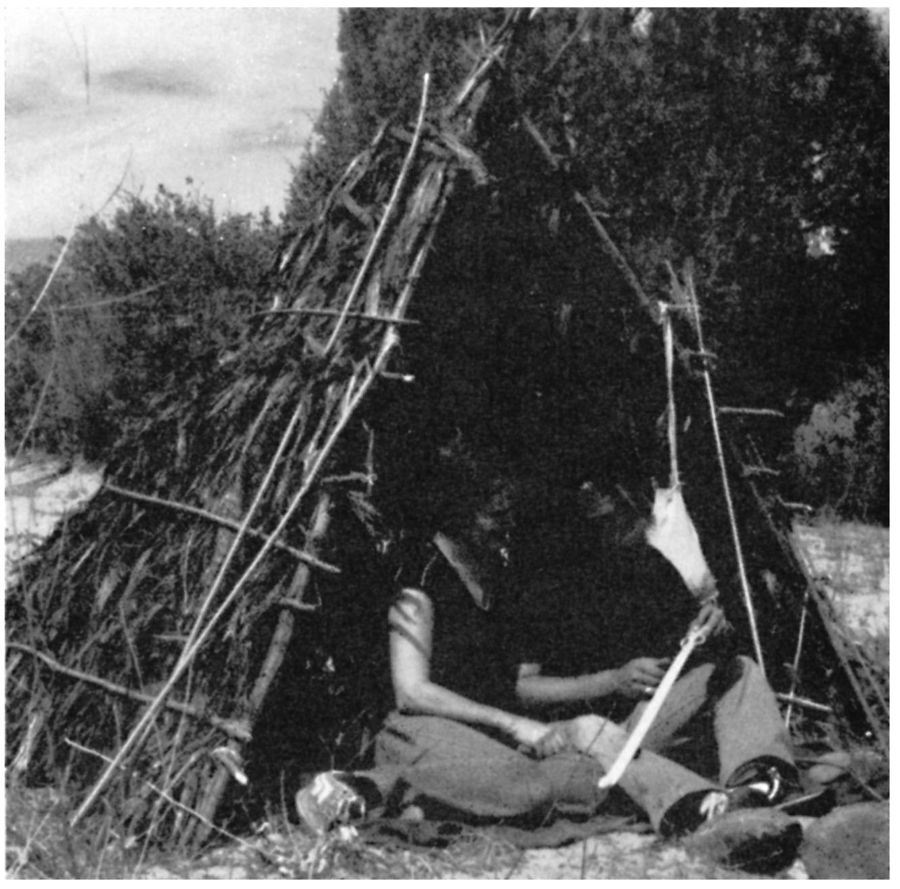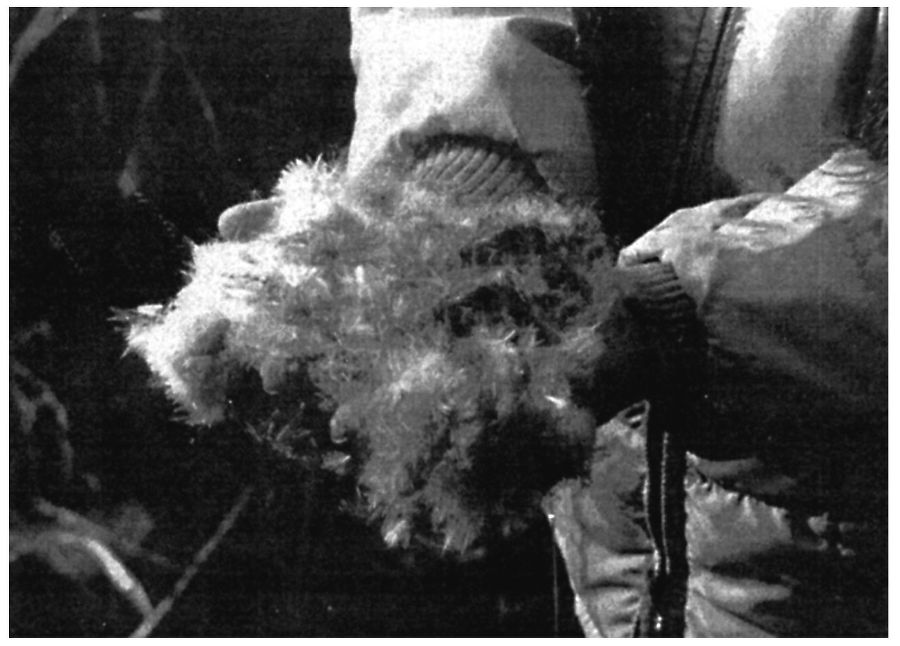I recall one particular morning, about 2 a.m., I heard some rustling and one of the younger girls crying. She was sleeping about 5 feet from the fire, her wood pile was too far away to reach and she was using her wool sweater for a pillow. We made a few adjustments, I put some warm rocks from the fire trench into the bottom of her blanket to warm her feet, and we both got a good night’s rest.
Most of us sleep with all our clothes on, including our boots for maximum insulation. This keeps us warm, but it can also create problems. Soles have actually burned right off the bottoms of boots while the wearer snores contentedly. Hair can also catch a spark if your head is too near the fire, so the best and safest way to sleep is lengthwise to the trench. Of course, this necessitates one fire for every couple of people, so we have devised other ways of maximizing our heat in really cold months. We huddle up on draft beds. But that’s another entire chapter (see “Primitive Comfort—The Hot Draft Bed”, Primitive Outdoor Skills, p. 131).

The wickiup is a spontaneous shelter that has two two common components: a frame and some sort of covering (Photo by Richard Jamison).
On the trail, everyone begins with equal advantage: blanket, knife, the clothes they are wearing, extra socks, a hat and a jacket. They don’t always end that way, as was the case for one careless fellow. It was early spring and the weather was unpredictable with fluctuating cold nights and warm days. Each morning he shed his jacket and shirt and just left them where he took them off-generally scattered all over camp. I took him aside and explained that, since his clothing was about all he had in the world on this trip, he should take better care of it. Peeling off a layer in the heat is one thing, whipping up a sage bark robe before the evening chill is quite another.
To some, sound advice lasts a lifetime, to others it disappears in the wind. The weather was mild until about the fifth day when I noticed gathering black clouds that signaled a possible front coming in. By the time storm clouds loomed on the horizon and darkness rushed in to close the day, temperatures fell rapidly and it was too late to build shelter from the bitter winds and cold. I suggested that we move our camp to an area with better shelter options, just in case. After the move we settled in, started new fires, staked out our sleeping positions and commenced to find firewood and set new traps for our meal the next day.
The temperature dropped and we put on our jackets and wrapped up in our blankets. Everyone except, you guessed it . . . We all began to search. “What does it look like,” we asked.
“A quilted Levi jacket,” he answered.
“Maybe you dropped it on the trail when we were moving,” someone suggested.
“No, I left it right here on this rock by the fire,” he assured us.
“Maybe this is it,” replied my son, as he fished five metal Levi buttons out of the ashes of the fire. The guy was devastated.
The next morning we woke up to three inches of unexpected snow.

Mature cattail seed heads offer profuse amounts of fluff that can be easily collected in quantity and used for insulation. (Photo: Richard Jamison)
Notes and References
Our Human Family
Notes:
1
Charles P. Mountford, Brown Men and Red Sand, (Melbourne: Robertson and Mullens, 1948).
2
Brian M. Fagan, The Journey from Eden: The Peopling of Our World, (London: Thames and Hudson, Ltd., 1990): 9.
3
Jared Diamond, “The Great Leap Forward,” Discover (May 1989): 57.
4
Epic of Man, Courtlandt Canby, ed., (New York: Time Incorporated, Book Div., 1961): 39-40.
5
Jared Diamond: 57.
6
Brian Fagan: 23-41.
7
Sharon Begley with Fiona Gliezes, “My Grandad Neanderthal?” Newsweek, (16 October 1989): 70-71.
8
Epic of Man: 18-23.
9
Robert Redfield, “The Folk Society,” American Journal of Sociology, 52 (January 1947): 299.
10
“The Search for Our Ancestors,” Kenneth Weaver, ed., National Geographic (November 1985): 614.
The Ultimate Weapon
Notes:
1
Gilbert Blue (Catawba), personal communication, 1979; Bill Brescia (Choctaw), personal communication, 1985; Richard Crowe (Cherokee), personal communication, 1980.
2
Tom Underwood, personal communication, 1988.
3
Claude Medford, interview with author, 1988.
4
Hayes Lossiah (Cherokee), personal communication, 1980.
5
Medford, 1988.
6
Blue, 1979.
7
Bonnie Wyatt, personal communication, 1989.
8
Roger McDaniel, personal communication, 1988.
9
Underwood, 1988.
10
Richard Crowe, personal communication, 1985.
References:
Bossu, Jean Bernard. Nouveaux Voyages Aux Indes Occidentales. Paris, 176.8. Kroeber, A.L. Anthropology. New York: Harcourt Brace, 1948.
Nash, Charles H. “Choctaw Blowguns.” Ten Years of Tennessee Archaeologist, 1954-1963. Vol. II. 1963.
Romans, Bernard “ A Concise Natural History of East and West Florida.” New York Vol I. (1775).
Speck, Frank G. “The Creek Indians of Taskigi Town,” Mem. American Anthropological Association. 2:1 (1907).
“Ethnology of the Yuchi Indians,” Anthropological Publications of the University Museum: University of Pennsylvania. 1:1 (1909).
“The Cane Blowgun In Catawba and Southeastern Ethnology,” American Anthropologist. 40 (1938).
Swanton, John R. “The Indians of the Southeastern United States.” Bureau of American Ethnology. Bulletin 137. 1946.
Timberlake, Lieut. Henry. The Memoirs of Lieut. Henry Timberlake (who accompanied the three Cherokee Indians to England in the year 1762) containing . . . an accurate map of their Over-hill Settlement. London, 1765.
Primitive Process Pottery
Brian, Wayne. Primitive Pottery Processes: Workshop Guide for Students. Mesa: Wayne Brian, 1990.
Fewkes, Jesse Walter. Archaeological Expedition to Arizona. U.S. Government Printing Office, 1897.
Harlow, Francis H. Historic Pueblo Indian Pottery. Museum of New Mexico Press, 1970.
Hartt, Fred. Notes on the Manufacture of Pottery. Rio De Janeiro: Office of South American Mail, 1875.
Lambert, David. The Field Guide to Geology. New York: Facts on File, Inc., 1988.
Lambert, Marjorie F. Pueblo Indian Pottery. Museum of New Mexico Press, 1970.
Read, H.H., and Janet Watson. Beginning Geology. New York: The Macmillan and Company, Ltd., 1966.
Societe d’Exploitation. Ancient American Pottery. Paris: Les Editions Du Chene, 1950.
Stacey, Joseph, ed. Southwestern Pottery Today; Special Edition. Arizona Highways, Vol. 50:5 (May 1974).
Stiles, Helen E. Pottery of the American Indians. New York: E.P. Dutton & Co., Inc., 1939.
Stone Survival Tools
Fisher, Donald B. “Stone Tools for Survival.” Dirt Times (Summer 1989). Hellweg, Paul. Flintknapping: The Art of Making Stone Tools. Canoga Park: Canyon Publishing Co., 1984.
Hellweg, Paul. “Grinding Arrowheads.” Flintknapping Digest (October 1984).
Yucca
Harrington, H. D. Edible Native Plants of the Rocky Mountains. Albuquerque: The University of New Mexico Press, 1970.